Mark Sisson's Blog, page 336
June 15, 2013
Guacamole-Stuffed Southwest Burgers
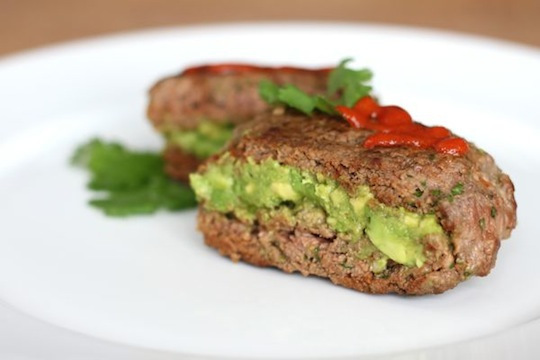 Burgers and avocados are a natural pairing, but instead of piling slices of avocado on top, why not stuff guacamole inside? The inspiration for this simple but genius recipe came from the Civilized Caveman, who adds sun dried tomatoes to his avocado-stuffed burgers.
Burgers and avocados are a natural pairing, but instead of piling slices of avocado on top, why not stuff guacamole inside? The inspiration for this simple but genius recipe came from the Civilized Caveman, who adds sun dried tomatoes to his avocado-stuffed burgers.
In the version here, burgers with a Southwest vibe are stuffed with lime-spiked guacamole. The combination of spicy seasonings and refreshing avocado is hard to beat. Yes, of course you could just serve guacamole on the side with regular burgers, but it’s not the same. When the guacamole is stuffed inside the burger, something magical happens. The meat and avocado become one.
These Guacamole-Stuffed Southwest Burgers are big and satisfying, every bite an explosion of flavor. They’re a delicious change of pace from regular burgers and an excuse to ditch ketchup for hot sauce and salsa.
Servings: 4 to 6
Time in the Kitchen: 45 minutes
Ingredients:
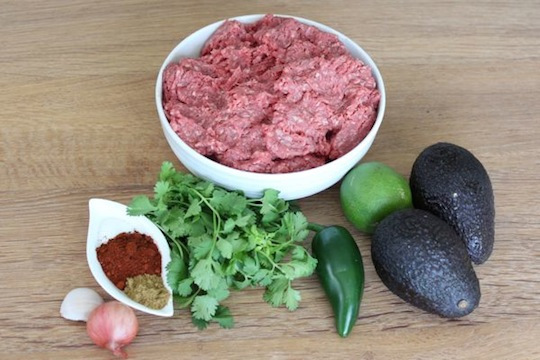
2 avocados
Juice from 1/2 a lime
1 shallot, finely chopped
2 pounds ground beef (900 g) http://www.marksdailyapple.com/the-di...
2 garlic cloves, finely chopped
1/2 cup finely chopped cilantro (120 ml)
1 jalapeno pepper or small green bell pepper, seeded and finely chopped
3 teaspoons chili powder (15 ml)
1 teaspoon cumin (5 ml)
1 1/4 teaspoon salt (5 ml)
Instructions:
Heat the grill to medium-high.
In a small bowl, mash the avocados with the lime juice, shallot and a pinch of salt. Set aside.
In a large bowl, mix together the meat with the garlic, cilantro, jalapeno or bell pepper, chili powder, cumin and salt.
Divide the ground meat into 6 even mounds. Split each mound in two and form two thin burger patties, one patty slightly bigger than the other.
Dollop a spoonful of avocado in the middle of the smaller patty, spreading it out slightly but making sure to leave a little rim around the edge of the meat.
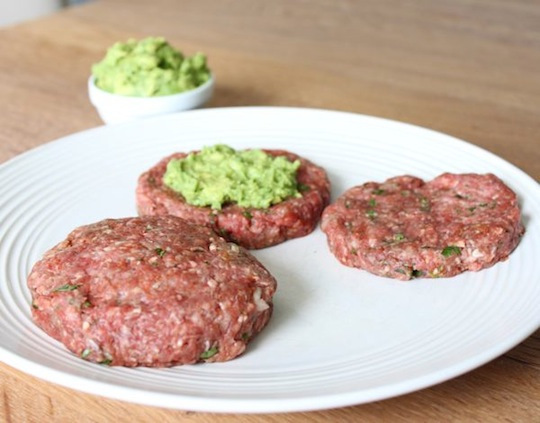
Set the larger patty on top and fold/pinch the edges together and shape the burger in your hands to form a tight seal around the guacamole.
Repeat with the remaining five burgers.
Grill the burgers 5 to 7 minutes a side or until cooked to your liking.
Serve with hot sauce or salsa on top.
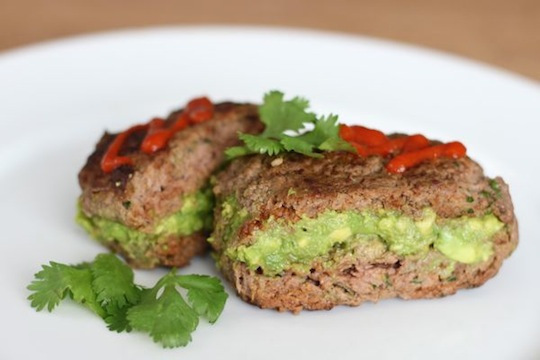
Not Sure What to Eat? Get the Primal Blueprint Meal Plan for Shopping Lists and Recipes Delivered Directly to Your Inbox Each Week

June 14, 2013
I Am Now the “Healthy Guy”
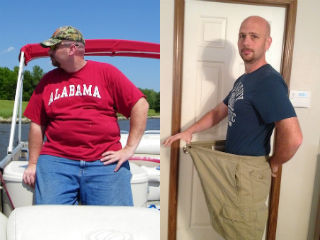
Name: Gabe
Age: 35
In Gabe’s words: “I feel better about myself, the way I look, the way I feel, and the way I live.”

I Am Now the “Healthy Guy”
It’s Friday, everyone! And that means another Primal Blueprint Real Life Story from a Mark’s Daily Apple reader. If you have your own success story and would like to share it with me and the Mark’s Daily Apple community please contact me here. I’ll continue to publish these each Friday as long as they keep coming in. Thank you for reading!
 Dear Mark,
Dear Mark,
I was never concerned with my health, my weight or my looks. I joined the Marine Corps in 1998 weighing 190 pounds and left boot camp at 165 pounds. I quickly gained back about 15 pounds and sat at 185 throughout most of my Marine Corps career. During this time, I exercised a lot but didn’t really restrict my diet very much. I had a high body fat percentage even though I was making weight requirements. When I injured my knee and could no longer keep the Marine Corps PT pace I began to gain weight. I left the Marine Corps in January of 2002 weighing 200 pounds. I quickly began eating junk that I had not allowed myself while in the service. By the time my wife and I moved back home to Mississippi in 2003, I was weighing around 250 pounds. I got a job working in corrections when we moved back. The hours, stress, and lack of time to exercise caused my weight to bloom to an all-time high of 315 pounds. I wore a size 48 pants and a size 3XL shirt. I spent 8 years in corrections. Six of those years were in a supervisory role. My blood pressure was regularly at 190 over 95.


In 2012, I decided to leave corrections because it was killing me. I didn’t have time to spend with my family or my church. I was unhealthy, stressed, and grossly overweight.
Leaving corrections gave me the opportunity to enjoy social media, which was a security risk before. When I got onto Facebook, I found and friended a former Marine Corps buddy of mine, Seth Williams. Seth told me that he’d had a life changing experience with this new lifestyle he had discovered called the “caveman” diet. He gave me this website, marksdailyapple.com.
At first I was very skeptical. I have seen so many “lose weight” schemes that I had become jaded. I was wondering where the hook was, or the catch, or the money making trap. But I had come to a point in my life where I wanted to change. I wanted to hit the “reset” button. So I went to MDA. And it seemed very very simple. It fit totally with the lifestyle I wanted to have. I always enjoyed meat and veggies and never really loved bread and pasta. I didn’t want to believe how easy it sounded.
I started at the end of June 2012, with the diet change. I stopped eating bread, fried stuff, sugar, and legumes. I stopped going to the gas station for chicken and chips. I stopped eating fast food completely. Because I was trying to lose weight, I began watching the amount of carbs I took in. I fasted through breakfast and lunch a couple of days a week. The only thing I refused to give up was Coke Zero.
After a week, I began to have to cinch up my belt. At the end of a month, I couldn’t keep my pants up and had to punch holes to make my belt fit. At that point, I began to exercise as well. When I started, I could only do one single push-up. The rest was done on my knees. I began to work out doing pushups and sit-ups every other day.
In September 2012, I had to buy a new wardrobe because my clothes were all too big. I was wearing a 36 pants size at that point and a size large shirt. By Christmas 2012 I had dropped below 200 pounds. My stomach had gotten so used to small portions of meat and veggies, that when I eat more than I normally do, I feel sick. I can’t handle large portions. Even the thought of eating bread is revolting to me now. Now I weigh between 185 and 190 pounds. I am in a size 34 pants and a medium size shirt.

I have introduced more carbs into my diet since I have begun to level out my weight. I cheat on the diet every now and then, with some sweets (about once a week), but still stay away from grains. I have not been working out as much as I want to. I still have some fat that I want to lose and the Primal lifestyle is the way to do it.
I ran 4 miles last weekend up hills near our home while my 8 year old rode her bicycle. That was something I could never even have imagined doing a year ago. My blood pressure was 126 over 76 when I checked it last. I can do 40 pushups and over 100 crunches. I feel better about myself, the way I look, the way I feel, and the way I live. To top it all off, I was able to fit into my Marine Corps Dress Blues last week. I am now the “healthy guy”. Everyone has been asking me how I did it. I always give them the MDA website. MDA changed my life. Thank you, Seth, and thank you, Mark!

Gabe
Get the 7-Day Course on the Primal Blueprint Fundamentals for Lifelong Health Delivered to Your Inbox for FREE

June 13, 2013
Have You Achieved Your Physical Potential?
 “If we did all the things we are capable of, we would astound ourselves.”
“If we did all the things we are capable of, we would astound ourselves.”
- Thomas Edison
Remember when you were a kid flying down the street as fast as your dirt bike would propel you? How about on the swing set, pumping your legs madly, targeting angle and timing for maximum lift until you felt like you would fly over the overhead bar? What about that sheer thrill of legs going so fast they almost felt like they were coming loose as you chased your friends (or were chased) down a trail? As kids we were an unrelenting ball of will, every moment looking to test boundaries, defy limits, overturn physics. We were in love with speed and heights and adventure, yes, but I think we were amazed by all of our own capabilities – the new (and ever enhanced) capacities we were always discovering. Decades beyond those wild days of youth, we’re still each in possession of an amazing human body. We each still hold untold genetic potential – potential that, as the Edison quote suggests, would astound us. The question is, what do we do with this potential? Do we chase it down with the same fervor of our 10-year-old selves? Do we put it on the mental back burner in the name of adult responsibilities? Have we simply forgotten about it – or given up on it entirely?
We go to the gym perhaps. Maybe we bike to work or get our 10,000 steps in each day. We get out for a hike every couple weeks during the milder seasons. Some of us perhaps struggle to meet any, let alone all, of these tasks. Either way, the question of potential – genuine, raw, lofty potential lingers. Do we ever wonder what we’d be capable of if we tried? Maybe from time to time we think of what we might “look like” if we went all out in the healthy living routine and really pushed our workouts. I have nothing against vanity, but that’s not what I’m talking about. I’m talking about physical achievement – seriously challenging ourselves. Maybe once upon a grade in high school or college, we were at the top of whatever game, but who wants to live feeling like their potential is old news, a memory in a yearbook? Living our physical capacity shouldn’t be just a blip in our biographies.
It seems like we’ve delegated physical pursuit in our culture. We’re much more inclined to watch athletes instead of become them. We’ll spend hours watching sporting events on a screen or in the stands but come up with every excuse in the book to not bother starting even a pickup game of our own. We revel in analyzing the minutiae of total strangers’ performances but never venture our own attempts. Content with experiencing that level of physical exertion and development vicariously through a satellite feed, we become more sedentary and detached from our own physical selves. We forgo and often forget what it means to move, to push our bodies, to come up against our own limits, let alone extend them through discipline and ambition.
It seems like a waste – to never know what it means to fully thrive in our bodies. What would it feel like to be strong, to be swift, to be graceful, to be in the “zone.” How would you feel differently about your life, yourself?
I love the idea of coming to the end of my abilities. There’s something immensely thrilling and therapeutic to it. Of course I’m always back for more, to push the envelope further, but I love not knowing if I can do something and attempting it anyway. Will we be happy, settled, satisfied if we make our way through life without testing ourselves, without taking life for the ultimate ride? Time, of course, is no excuse. As we get older, we too often feel like our lives contract. There’s a certain wisdom to that – realizing you don’t need to learn 8 foreign languages or be a professional soccer player to be the person you can and want to be. Nonetheless, how much do we miss by letting our physical potential languish – to never push the outer edges of it, to never inhabit our bodies fully enough to see their potential realized?
I’m not recommending people give up all their free time to suddenly pursue extreme training. Nor am I suggesting getting on the chronic cardio track. If you’re wired and inclined that way, I get it. Do it and enjoy. If you’re not wired that way or so inclined, by all means, don’t! That said, discover an endeavor that would inspire you to push yourself, to achieve something you’d enjoy and be proud of. That doesn’t mean what will get you the most recognition or what you think others commonly do. Think for a minute what ultimate vitality would mean for you. What would it look like in your life? How would reaching and experiencing your potential figure into that?
Honestly, I think that’s half the fun of it – deciding what physical goal or adventure you want to go after based on your interests and personality. Maybe it’s climbing a mountain or getting a black belt in a martial art. Maybe it’s competitive dancing or reaching the level of personal investment and physical ability in yoga. Perhaps it’s doing a Tough Mudder run or competing in something like a community sports league or CrossFit regionals. On the other hand, maybe it’s cycling across the U.S. or running that marathon. Maybe for right now it’s signing up for your first 5K. It all starts somewhere. Wherever your personal passion and your physical goals intersect, maybe that’s where you should head.
Because this life goes fast. In the midst of all the daily chaos and commutes, the work and errands, we remember to mow the lawn but too often forget to fulfill the deeper, less obvious possibilities of our human lives. We forget to explore and stretch the boundaries of our experience – like we did as children. We deserve to enjoy our bodies and revel in their full capacities – to discover the capacities and nuances of their performance. We deserve to live our lives astounded by ourselves.
Thanks for reading, everyone. Let me know your thoughts on inhabiting your body and living your physical potential. Have a great end to the week.
Get the 7-Day Course on the Primal Blueprint Fundamentals for Lifelong Health Delivered to Your Inbox for FREE

June 12, 2013
Salt: What Is It Good For?
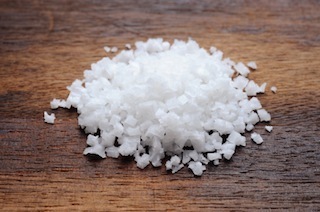 Other than saturated fat, I can’t think of a nutrient that’s been so universally maligned and demonized as salt. All the experts hate it and recommend that we get as little of it as possible. They even all seem to have their own little anti-salt slogans. The American Diabetes Association recommends between 2300 and 1500 mg of sodium per day (“Be Sodium Savvy“). The American Heart Association wants you eating less than 1500 mg per day (“Shaking the Salt Habit“) and claims that 97% of young people already eat way too much salt. The other ADA – the American Dietetic Association – also recommends between 2300 and 1500 mg, but their slogan is far inferior (“Slice Your Sodium Intake“). It’s quite the pile-on, isn’t it?
Other than saturated fat, I can’t think of a nutrient that’s been so universally maligned and demonized as salt. All the experts hate it and recommend that we get as little of it as possible. They even all seem to have their own little anti-salt slogans. The American Diabetes Association recommends between 2300 and 1500 mg of sodium per day (“Be Sodium Savvy“). The American Heart Association wants you eating less than 1500 mg per day (“Shaking the Salt Habit“) and claims that 97% of young people already eat way too much salt. The other ADA – the American Dietetic Association – also recommends between 2300 and 1500 mg, but their slogan is far inferior (“Slice Your Sodium Intake“). It’s quite the pile-on, isn’t it?
Why does salt strike mortal terror into the hearts of so many?
Back in the 1980s, a massive global study of salt intake and blood pressure called INTERSALT was undertaken. Overall, it showed a modest association between the two, but some groups, particularly the undeveloped, non-industrial peoples who had very little access to salt (and other trappings of industrialization), had blood pressure that was generally extremely low. Foremost among these groups were the Yanomami of the Amazon rainforest. The Yanomami have very low sodium excretion, which indicates very low sodium intake, and very low blood pressure. Even the elderly Yanomami enjoyed low blood pressure. This was convincing. I mean, it sounds convincing, right? Low salt intake, low lifelong incidence of hypertension – how much more cut and dry can you get? This low salt/low blood pressure connection seemed to also apply to other groups who happened to be living more traditional ways of life.
Except that there’s another non-industrialized group (and you only need one) whose slightly different results kinda muck up the Yanomami argument: the Kuna of Panama.
Among the Kuna, a tribe native to Panama, both salt intake and blood pressure were also historically low well into old age. To study whether the two variables were linked, researchers examined a group of “acculturated” Kuna with ample access to salt and an otherwise strict adherence to their traditional way of life. Little changed but the salt intake, in other words. But, despite consuming an average of 2.6 daily teaspoons of salt (and sometimes up to 6 teaspoons), the Kuna did not have hypertension, not even in old age. There was no change between the hypertensive statuses of 20 year old Kuna and 60 year old Kuna.
All in all, drastic reduction of sodium can reduce blood pressure by a few points. The evidence is pretty consistent on that. But the example of the Kuna shows that there’s way more to blood pressure than how much salt you eat, like how much potassium you eat.
Consider two recent Cochrane meta-analyses. The first, on sodium restriction and blood pressure, found that for people with hypertension the mean effect of sodium restriction was -5.39 mm Hg for systolic blood pressure and -2.82 mm Hg for diastolic blood pressure. In normotensive people, the figures were -2.42 mm Hg and -1.00 mm Hg, respectively. Decent reductions, I suppose, but what about potassium and blood pressure?
The upper intake of potassium was associated with over a 7-point drop in systolic blood pressure and a 2-point drop in diastolic blood pressure, but only in people with hypertension (the people who actually should lower blood pressure). Unfortunately, the official recommendations for sodium and potassium intake cannot be met simultaneously. Yep – the experts want you to eat in a way that is literally impossible to accomplish. Inspires confidence, doesn’t it?
Let’s forget about blood pressure for a second, because there’s also way more to health than the meager drops in blood pressure afforded by sodium restriction. Recent evidence suggests that for many people, all out salt reduction has an overall negative impact on several other aspects of health:
In 2011, one study showed that seven days on a low salt diet increased insulin resistance in healthy men and women when compared to a higher-salt diet.
Another study showed that while reducing salt moderately improved the blood pressure of hypertensive patients by a mere 4.18 and 1.98 points for systolic and diastolic, respectively (but not of people with normal blood pressure), it also had negative effects on multiple other health markers, including increased triglycerides and LDL and elevated stress hormones.
Another 2011 study found that eating a low salt diet (under 3 grams of sodium per day, or just over a teaspoon of salt) and a high salt diet (from 6-7 grams of sodium per day, or well over two teaspoons of salt) both increased the risk of stroke and heart attack, while eating between four and six grams of sodium, or about two teaspoons of salt, each day was associated with the lowest risk of cardiovascular incidents.
A recent study found that salt intake followed a J-curve, with low and high intakes increasing arterial plaque formation and a medium intake decreasing it.
Sodium depletion due to “low-sodium nutrition” has been shown to trigger overtraining-like symptoms, including hypertension and sleeping disorders.
The greatest health marker of all – being alive – also has an interesting association with salt intake. It seems that, time and time again, folks with a “medium” salt intake live longer than people who eat too little salt or too much salt. That amounts to roughly 4000 mg of sodium, or close to two teaspoons of regular salt.
Sodium intake affects other markers of vascular health beyond just blood pressure, too:
Greater sodium excretion in the urine (a common marker of sodium intake) may be positively associated with large arterial compliance. Large arterial compliance is a measure of arterial elasticity, or the ability of one’s arteries to handle fluctuations in pressure. Stiffer arteries are more prone to damage.
Low sodium status (whether dietarily-induced or caused by increased sodium loss) can also increase aldosterone, an adrenal hormone that seeks to preserve sodium in the body when it’s perceived to be scarce. High aldosterone levels are associated with insulin resistance, and aldosterone blockers are being explored as potential treatments of vascular disease and hypertension.
Well, what is salt good for?
That question honestly isn’t asked very often in the literature, but we can surmise some of the benefits just by looking at what happens in people on a low-sodium diet. If that connection persists, then adequate (not excess) salt probably helps prevent some of those problems, like insulin resistance, plaque formation, increased stress hormones, worsened blood lipids, and elevated aldosterone.
There are, however, outright positive effects of salt consumption, too:
Salt supports hydration, especially during exercise.
Of the electrolytes, potassium gets all the attention, even though sodium is just as important. Studies show that sodium loading before exercising in the heat increases fluid volume and reduces the physiological strain of the subsequent training. In other words, consuming sodium before training “involved less thermoregulatory and perceived strain during exercise and increased exercise capacity in warm conditions.” You can workout harder, longer, and more effectively with sufficient sodium in your diet. Salt loading also boosts performance in thermoneutral conditions, not just hot weather.
I remember drinking so much plain water during one race that I actually became dehydrated from pissing out all my electrolyte stores and almost passed out. From that point on, a few teaspoons of salt would solve the problem and prevent it from occurring again. The much ballyhooed bananas didn’t do it. Only pure, unmitigated salt did the trick. Hardcore ketogenic athlete/doctor Peter Attia does the same with his bullion cubes, which he credits for maintaining his performance.
Salt may help you cope with stress.
This is a guess on my part, based on several lines of evidence. First, salt has been shown to speed up cortisol clearance from the blood. The faster you clear cortisol, the quicker you recover from a stressor. If cortisol lingers, you “stay stressed.”
Second, there’s evidence that stress increases salt appetite. In lab mice, activation of the sympathetic nervous system by a stressor causes them to prefer salt water to plain water. Similar findings have been observed in rats subjected to stress. In humans, acute bouts of stress don’t seem to increase salt appetite, but chronic stress does increase intake of salty, processed junk food. Obviously, eating McDonald’s fries doesn’t help improve your health, but I find it highly plausible that salting your healthy Primal food to taste could be an important ally against stress. It’s just that when most people need “something salty,” they reach for potato chips, not a couple soft boiled eggs dipped in sea salt.
Third, as I mentioned above, low sodium diets are often associated with elevated stress hormones.
Personally, I’m drawn to salty foods – often jerky or macadamia nuts sprinkled with some sea salt – when I’m up against a deadline, and it seems to help.
It makes food taste better.
Yes, some people would claim this attribute as a negative. Adding salt to food will make you more likely to overeat and gain weight and develop the diseases associated with weight gain and so on and so forth. But I’ve always held that eating good food is one of life’s highest, purest pleasures. If your food doesn’t taste good, there’s no point in eating it. We’re not machines concerned only with fuel. We are sensory, sensual beings with the capacity for appreciation of thousands of flavors. To deny the pleasure of food is to deny our humanity.
Salt can also make otherwise unpalatable – but healthy – food somehow palatable. A plate of steamed kale is boring and bitter. A plate of steamed kale with sea salt and olive oil is delicious and inspiring. Plain broccoli? Kids everywhere are spitting it into napkins and stuffing them into their pockets. Broccoli stir-fried with soy sauce (or tamari, if you please)? Kids everywhere are mailing in their dues (and signing up for auto-pay) for the clean plate club.
You could drop your salt intake to half a teaspoon and get a three or four point drop in your blood pressure. Of course, you might not enjoy your food anymore, your performance in the gym or on the trail would likely suffer, your stress hormones might be elevated, you might start feeling overtrained without doing any actual training, you could become insulin resistant, and you may have trouble clearing (the elevated) cortisol from your blood. But, hey: your blood pressure readings will likely improve by a few points! Or, you could keep your salt intake up around two teaspoons, give or take, simply by salting your food to taste, and avoid all that other stuff.
Your choice.
What do you think, readers? Do you fear salt? Do you relish it? Do you find your salt appetite increases under certain conditions? Let me know in the comment section!
Get the 7-Day Course on the Primal Blueprint Fundamentals for Lifelong Health Delivered to Your Inbox for FREE

June 11, 2013
What You Should Know About Pork Production Claims
 I’m grateful once again to have our friend David Maren of Tendergrass Farms pen today’s guest post. This is the second post in a three part series on the assertions that retailers make about the way their poultry, pork, and beef is raised.
I’m grateful once again to have our friend David Maren of Tendergrass Farms pen today’s guest post. This is the second post in a three part series on the assertions that retailers make about the way their poultry, pork, and beef is raised.
In last week’s post I shared some information about a few common and often misleading claims that poultry companies make about the way their chickens and turkeys are raised. We looked at the fact that while most companies don’t actually lie to their customers directly, they do rely on meticulously calculated marketing terminology that leads their customers to believe that their birds were raised in ways that they, in actual fact, were not. I labored to expose the unfortunate reality that many poultry companies respond to the public’s demand for alternatively raised birds with dishonest advertising rather than real changes in the lucrative CAFO poultry production system that their customers increasingly don’t want to support. In the pork industry today, we face many of the same realities of deceptive marketing, empty claims, and regulation loopholes – a few of which I will attempt to uncover in this post. I won’t bore you with an explanation of every pork claim used in this day and age but the examples below can serve as illustrations of the type of analytical discernment needed in the marketplace today.
In the spirit of full disclosure I should start by mentioning that I happen to love raising and eating pastured pigs. This evening as I sit at my desk on my little farm here in Floyd County, Virginia, a herd of less than 20 pastured pigs is lying outside my bedroom window in a big snoring heap in the tall grass. I think that pastured pork farming is pretty cool. However, I happen to have a first cousin in Iowa whom I respect considerably even though he raises pigs using a very different model. He almost single-handedly raises about 25,000 pigs every year in 14 state of the art fully computerized CAFO buildings. I’ve seen his operation many times and I know that he is proud of what he does. The system that he runs is an extraordinary example of engineering genius and he feeds a tremendous number of people through the conventional pork system that he’s a part of. While I differ with him greatly from an applied agricultural philosophy standpoint I respect him as a fellow farmer nonetheless.
I bring this up because although I might enjoy writing an article on exactly why I believe that the pork that I raise is better than the pork my cousin raises, my intention throughout this 3-post series on livestock production claims is to inform you about the choices you have when it comes to buying meat, not to convince you to share my particular point of view. In the paleo community there are lots of worthy articles that have already been written regarding the health benefits of grass fed meats, pastured meats, and omega-3’s so I feel no need to convince anyone of the merits of one production method over another in this series. My objective is to sketch a broad but accurate outline of the primary ways that pigs are raised and the methods by which these differing production models are craftily misrepresented through marketing. In short, my goal is for you to be able to tell my cousin’s pork from mine when you go shopping this week despite the haze of promotional terms that you may encounter, no matter which one you end up actually purchasing.

In this screenshot the Niman Ranch website expounds on their pork’s “all-natural” claim
“All-Natural”
Niman Ranch is probably the most renowned name in the natural pork industry. It was founded in the early 1970’s by a man by the name of Bill Niman. Bill originally raised 100 percent of their pork on pasture. Now Niman Ranch is owned by Natural Food Holdings (part of Hilco Equity Partners). The Niman Ranch homepage features an uplifting photograph of a couple of speckled sows, outdoors, grazing with a few piglets trailing behind. On the page that details the superiority of their all-natural pork it is mentioned that the genetic lines that they use are “particularly well suited to an outdoor environment.” Lastly, the statement is made that Niman Ranch pork is “raised outdoors or in deeply bedded pens.”
The term “natural” is a term that the FDA has yet to define (with or without the modifier “all” which just means “entirely”). The FDA, however, does say that “the agency has not objected to the use of the term if the food does not contain added color, artificial flavors, or synthetic substances.”1 The USDA’s Food Safety and Inspection Service goes slightly farther in saying that when the term “natural” is used the meaning of the term must be specified2 (as Niman Ranch does above). Note that this means that according to the FDA and the FSIS definitions (or lack thereof), the term “all natural” doesn’t necessarily have any bearing whatsoever on how the animal was actually raised. It simply means that it does not contain added color, artificial flavors, or synthetic substances. While it certainly can mean more than that, it doesn’t have to. As far as you know, was there ever any practical need to add food colorings, flavorings, or any other ingredients to a raw pork chop to start with? I don’t think so.
Now let’s look at the whole picture. The Niman Ranch website shows photos of pigs grazing on grassy pasture. It says that the Niman Ranch pigs are genetically well suited for the outdoors. Notice, however, that the only direct claim about how their pigs are raised says “raised outdoors or in deeply bedded pens.” Hang on a second, did they really just say “or”? From my experience, raising pigs outdoors where they can actually graze is quite expensive (mostly due to labor and land costs) and, rather conveniently for Niman Ranch, the use of the word “or” allows them to raise up to 100% of their pigs in “deeply bedded pens” while still maintaining that this statement is technically true.
A year or two before I co-founded Tendergrass Farms I seriously considered raising pigs for Niman Ranch. I was struggling to find a viable market for my pastured pigs locally and I thought that at least from what I had read on their website they looked like a company that I’d be happy to partner with. I contacted the Niman Ranch headquarters and was given a cell phone number for the field representative who was responsible for my region. One of my first questions for him was about their production standards. I believe I asked him how many pigs Niman Ranch recommended to graze per acre of pasture or something similar. As soon as I had asked the question I could almost see him smiling over the phone line as he explained to this young naive farmer that only a small percentage of Niman Ranch pigs are actually raised on pasture. In the whole east coast region he said that there are virtually no pasture-based Niman producers. In preparation for this blog post I sent him an email this week to make sure that this was still true. He confirmed just yesterday that by his estimate well over 75% of Niman Ranch pig farms utilize warehouse-style buildings with straw for bedding, referred to as “deeply bedded barns.” During those first few conversations that we had a few years back he also told me that for the most part they had moved away from the traditional Duroc, Chester White, and Berkshire breeds that the website boasts about in favor of modern breeds developed by a certain multinational genetics company called PIC. Shocked and even slightly disillusioned, I quickly gave up the idea of ever raising pigs for Niman Ranch.
Does all of this mean that Niman Ranch pork is bad pork? I probably wouldn’t say that. But I would definitely be willing to say that the average Niman Ranch customer has likely been deceived into believing that they’re eating pastured pork when in fact they are not.
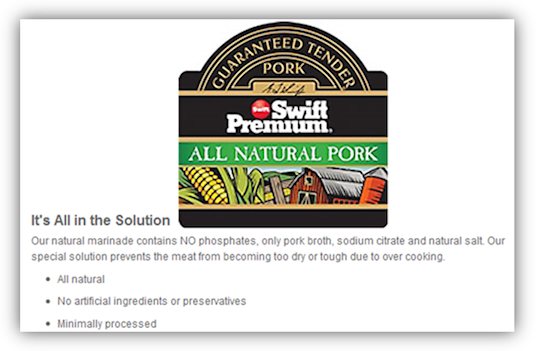
This Swift brand “premium” pork uses a different definition of “all natural” from the one used by Niman Ranch
“Premium,” Paylean, & Artificial Growth Promotants
Notice that this pork claims to be “premium.” As you may already be aware, this term does carry along with it a very strict government standard – but only in the context of high octane gasoline. When it comes to meat, “premium” means nothing at all.
Observe also that the definition that Swift uses for “all natural” is entirely different from that of Niman Ranch. One key element that is missing from Swift’s product description is the issue of artificial growth promotants and subtherapeutic antibiotics. You might just assume that “all natural” pigs wouldn’t be raised with a daily ration of antibiotics or pharmaceutical growth enhancers but in fact there is a very high probability that this product in made from pigs that were fed these types of additives right up until slaughter.
Artificial hormone use is illegal in pork production in the US but the use of other artificial growth-promoting chemicals is extensive, far beyond the mere use of antibiotics for this purpose. The best example of this is a chemical feed additive called Paylean. Paylean is the brand name for ractopamine, a beta-adrenoceptor agonist that artificially promotes leanness in pigs.3 As the paleo world is already well aware, most Americans don’t like to eat much lard. This causes big problems for the pork industry but Paylean eases the burden. Pigs are naturally very fatty animals and Paylean greatly decreases the amount of fat that pigs produce as they grow. Unlike some drugs, Paylean requires no withdrawal period whatsoever so pigs can be fed Paylean even on the day of slaughter. The Swift brand “all natural” pork in the image above was in all likelihood given this drug. Isn’t it interesting that ractopamine has been banned in all pork in mainland China, Russia, and the European Union but in the US it is allowed to be used even in “all natural” pork?
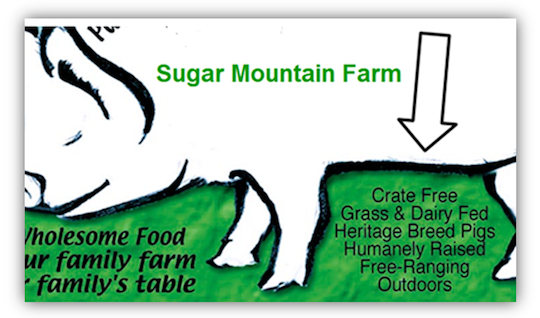
A close up of a Sugar Mountain Farm pork label claiming to be free ranging outdoors, & “crate free.”
Free Ranging Outdoors/Pastured, Crate Free
The most striking characteristic of the marketing claims that are made on this label compared with those made by Niman Ranch and Swift above is their uncompromising specificity. The term “free ranging outdoors” (not to be confused with “free range”) is actually synonymous with “pastured.” Both terms would refer to the fact that the animals at Sugar Mtn. Farm are actually raised outdoors where they forage for grass and other green leafy matter as a source of food. As with poultry, the term “free range” is often used to refer to pigs raised in CAFO-style buildings with small areas outdoors where the pigs may or may not occasionally venture out – far from the grassy meadow that the term “free range” tends to bring to most people’s minds. Sugar Mountain Farm, however, specifically says that they free-range their pigs outdoors. If you take a look at their website you’ll see hundreds of photos that show that this is true even in the coldest winter months in Vermont when they have to actually feed their pigs hay!
The term “crate free” is somewhat less common. It refers to the fact that Sugar Mountain Farm pigs are raised from piglets born to sows that are managed without the use of gestation or farrowing crates. Gestation crates are an invention of the modern pork industry that resembles a cage slightly larger than the sow that resides within it. Gestation crates are a very space efficient (but arguably cruel) way to house sows during their 3 month, 3 week, and 3 day gestation period. Sugar Mtn. Farm makes it clear that they don’t use this management method with their sows by calling their pork “crate free.”
The other type of crate that is often used in the pork industry is the farrowing crate. The word farrow simply means to give birth in porcine terminology so a farrowing crate is a tightly confined area, usually about 3’ by 6’, where the sow gives birth to her piglets. In order to keep the 2-pound piglets from being crushed by their 400-pound mother they are usually confined to the farrowing crate for the first three to four weeks after birth. Protective “roll bars” allow the piglets plenty of room to walk around where their mother can’t kill them by mistake when she gets up, sits down, or rolls over. While Sugar Mountain Farm boasts that they don’t engage in this type of sow management the alternative may not be as humane as you would hope. When sows are given sufficient space to move around freely with their piglets the number of piglets that are stepped on and crushed to death goes up dramatically. On the farrowing crate question you essentially have to decide whether you feel that a sow being cramped and uncomfortable for a few weeks is more humane than a bucket of dead baby pigs. There are pros and cons on both sides of the issue but as we have seen with all other production claims so far it’s critical to put aside assumptions and do some research before supposing too much. There are some people who, through their research on the topic, have actually come to the position of being anti-gestation crate but pro-farrowing crate. This has been a very hot topic for even the biggest pork firms over the last few years.
I once brought this idea up to a lead researcher at a University of Minnesota alternative swine systems development program. Keep in mind that the man had spent a large part of his career developing “humane” alternatives to farrowing crates. I had just recently visited a farm where I had seen a sow that had killed all 9 piglets that she had given birth to because she was in an open pen with them. I asked the researcher if he really thought that farrowing crates were inhumane after taking into account the deaths of so many piglets that are virtually unavoidable in alternative systems. He said, “David, I actually agree with you. But the problem is that if you stood by that position you’d just be a voice in the wind. The consumer believes that farrowing crates are inhumane so we need to look for good alternatives.” (Just for the record there are no Tendergrass partner farms that currently use farrowing crates but we have a neutral stance when it comes to our farms purchasing piglets that were born in them.)
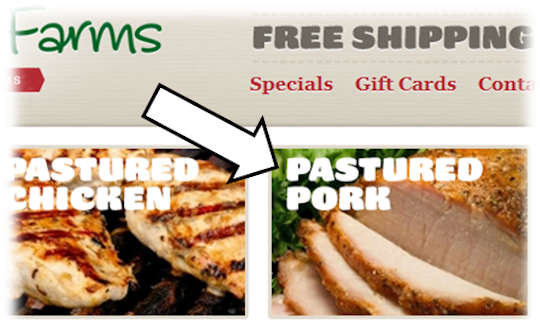
A Tendergrass Farms website screenshot showing that we claim to sell pastured pork
Pastured Pigs and What They Eat
Here are Tendergrass Farms we call our pork a lot of things but one of them is “pastured.” One of the most common questions that we get here at Tendergrass Farms is, “Do you feed your pigs anything other than grass?” As with pastured poultry, many people assume that because we raise our pigs on grassy pastures then grass must be all they eat. The problem is that in order to function biologically pigs need a good source of protein, specifically lysine. Pigs are very resilient creatures so even though it isn’t necessarily good for their health it is in fact theoretically possible to raise them on pasture alone because they do eat a certain number of grubs and other insects that contain protein. That said, pastured pigs are almost universally rotationally grazed on pasture with access to some type of alternate feed source to keep them healthy. The nature and quantity of protein-rich feed that the pastured pigs are given varies a lot from farm to farm but the most common lysine sources are corn, roasted soybeans, and even out-of-date milk. In the case of Tendergrass and my pigs specifically, we even go to the trouble to make sure that the corn and soy that they’re fed was grown from non-GMO seed.
Don’t Make Assumptions, Ask Questions
The best way to hold your pork provider accountable is to make sure that you really understand any and all claims that are being made. As I said regarding poultry, if an organization is marketing its products with integrity they’ll be proud to define their terms. There mere fact that certain pork may be called “gourmet” and sold on a website that also offers grass fed beef doesn’t mean that it’s necessarily what you hope it is. Pasture raised pork demands a premium price and unfortunately there are plenty of companies that are happy to take your money even if they can’t give you exactly what you came for.
Hey there, pig man – No giveaway coupon with this post?
Being that this is a post about pigs it seemed appropriate to just offer you all the leftover coupon scraps from the past two posts that haven’t been cleaned up yet.
The coupon code that we offered last week still has a few more redemptions left on it. Here’s the deal:
We’ve created a coupon code that’ll give you ten (10) free one pound packs of our pastured ground turkey (a $99.90 value) with all orders over $199 which will also qualify your order for Free Shipping. Just head over to the Tendergrass Farms online grass fed meats store and toss $199 of our yummy grass fed beef, pastured pork, pastured chicken, or pastured turkey into your cart. When you’re ready to check out just apply the coupon code TRUST-US-ITS-REAL-10 in order for ten (10) pounds of pasture raised ground turkey to be miraculously added to your cart at a price of $0.00 (expires 9/30/13, limited to 135 redemptions, while supplies last).
If that code runs out before you get a chance to use it, you can always use the free pastured turkey breast coupon code FARMERS-RULE-123 from the turkey jerky post way back in March. Just keep in mind that both of these coupon codes are on a while supplies last basis.
Tip: If $199 sounds like a big first order just grab a couple friends from the gym and place an order together.
References:
1This quote can be found under “FDA Basics” on the FDA website.
2This regulation can be found on the USDA FSIS website under Meat and Poultry Labeling Terms
3The manufacturer of Paylean gives a helpful explanation of how it works on their site.
David Maren is a husband, father, farmer, and co-founder of Tendergrass Farms. Tendergrass Farms is a cooperative-style online grass fed meats shop that exists as a bridge between the often geographically isolated family farmer and committed grass fed meats enthusiasts like yourself. The Tendergrass Farms vision is to sustain family farms through making it easy for you to purchase their meats by taking advantage of appropriate technology and ultra-efficient transportation models that enable their meats to be shipped to fans all around the USA.
If you’re not already a huge fan of Tendergrass Farms, you’re missing out: Go bookmark their site , like their Facebook page , follow them on Twitter , and check out their grass fed blog!

June 10, 2013
Dear Readers: What Do You Want from Mark’s Daily Apple Videos?

It’s Monday and that usually means another round of Dear Mark, but today I have something a little different in mind. Today I have a question for you (along with a chance to win a Primal prize).
Since I launched Mark’s Daily Apple way back in 2006 it’s been my goal to help 10 million people take control of their health. While MDA now reaches millions of people every month I’m always looking for new ways to do a better job, so I’m coming to you for ideas. This is a joint effort after all. I couldn’t do it without you.
Over the years I’ve published nearly 4,000(!) blog posts. I don’t know the exact figure, but it’s probably upwards of 5 million words. That’s a lot of writing and I don’t have any plans to slow down, but I feel like it’s time to take things to the next level. I’m seriously considering publishing regular (say, monthly to start, and perhaps weekly down the line) Mark’s Daily Apple videos. Imagine instructional/how-to videos, interviews with experts in the paleosphere, and videos that give you some insight into my Primal life. While I have a few ideas of my own, nothing is set in stone just yet. That’s where you come in…
The Contest
“What do you want from Mark’s Daily Apple videos?” My blog, my books, what I do are constantly informed by your thoughts and ideas. Today is your chance to tell me what you’d like to see on my part in this next stage of Mark’s Daily Apple. In the comments section below, tell me your ideas for future Mark’s Daily Apple videos. What kind of videos would you prefer (educational, how-to, motivational, interviews, etc.)? Which topics interest you most (nutrition, weight loss, fitness/training, Primal lifestyle behaviors (sun exposure, sleep, stress management, barefooting, etc.), cooking, etc.)? Do you prefer short, medium or long form videos (less than 2 minutes, 2 to 5 minutes, more than 5 minutes)? And lastly, tell me the title of a video you would like to see made. That’s it. I’m really interested in what you personally would find useful, and what you think would best serve the Primal movement.
A winner will be chosen at random. Agreeing with other people is allowed (and encouraged), but only the idea comments will be counted for drawing purposes.
The Prize
A 15-serving pouch of both the Vanilla Coconut Creme and Chocolate Coconut Primal Fuel.
The Deadline
Midnight (PDT), tonight!
Who is Eligible
Everyone. I’ll ship the Primal Fuel anywhere in the world.
Thanks in advance to everyone that offers an idea. I’ll see what I can do to give you what you want! Grok on!
Get the 7-Day Course on the Primal Blueprint Fundamentals for Lifelong Health Delivered to Your Inbox for FREE

June 9, 2013
Weekend Link Love
 Before the usual links, some Primal Blueprint Publishing news. First, check this out. The Primal Connection just won the Eric Hoffer award for best self-published book in 2013!
Before the usual links, some Primal Blueprint Publishing news. First, check this out. The Primal Connection just won the Eric Hoffer award for best self-published book in 2013!
Second, the recipe for Paleo Pizza from Primal Cravings just got first place in the PaleoNonPaleo Great Paleo Pizza Smackdown.
And finally, for those of you who’ve picked up a copy of Primal Cravings, please consider writing a review on Amazon. Eternal gratitude is yours from me and the Keatleys. Thanks in advance!
Research of the Week
In case you needed another reason to have that glass of red wine, a new study suggests that it can help prevent kidney stones.
New isotope studies confirm that right around the time our human ancestors began growing bigger brains they either switched to a diet made up of lots of grass and cellulose, or lots of grass and cellulose-eating ruminants. Guess which one Discover Magazine went with. Guess which one I think is more realistic (and supportive of said bigger brains).
Interesting Blog Posts
How a New Zealand triathlete rendered his formerly severe osteoarthritis nearly nonexistent with a paleo diet rich in bone broth.
Science-based Medicine takes on coconut oil. What do you think of their take?
Media, Schmedia
PopSci “unearths” 8 ridiculous, commonly-held views of nutrition. Prepare yourself for a serious bout of deja-vu.
Boy, we’re really ruffling some feathers, aren’t we? Yet another “debunking” of ancestral health rears its head (and gets summarily shot down in the comment section).
Everything Else
Have a Paleo heart? Mike O’Brien doesn’t at the moment, but he desperately needs – and deserves – one. Consider donating a buck or ten to his fund so that he can afford the heart transplant he needs.
Monsanto is giving up on marketing GMO crops in Europe, at least for the time being.
Recipe Corner
The weather may be warming up, but I’d never turn down a plate of Caribbean oxtail stew.
Hey, you, Primal eater who’s vowed to “get more adventurous” and try more seafood. Go on and make some squid adobo.
Time Capsule
One year ago (Jun 9 – Jun 15)
How to Work Outside (Even if You’re a Desk Jockey) – Oh, it’s definitely possible, and here’s how to do it.
How to Fuel Ultra-Distances: The World’s Toughest Mudder – Even though I like to rag on endurance athletics, I secretly love to talk about training for and fueling it.
Comment of the Week
I knew listening to loud overbearing Conventional Wisdom could make you go deaf (and dumb)!
- Amen!
Get the 7-Day Course on the Primal Blueprint Fundamentals for Lifelong Health Delivered to Your Inbox for FREE

June 8, 2013
Crispy, Fatty, Melt-In-Your-Mouth Porchetta
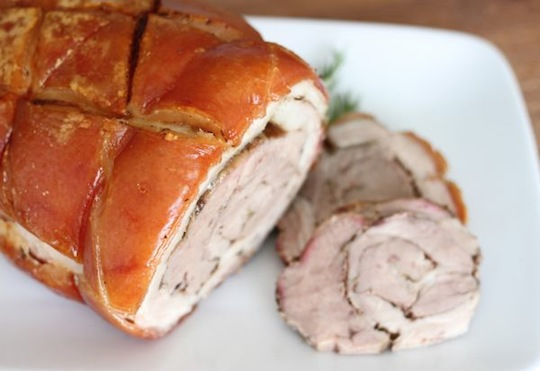 Porchetta is the ultimate meal for pork lovers. Crispy, crackling pork skin; fatty, melt-in-your mouth pork belly; and moist shoulder (or loin) are rolled together in every bite. It’s pork, three ways, in one amazing dish.
Porchetta is the ultimate meal for pork lovers. Crispy, crackling pork skin; fatty, melt-in-your mouth pork belly; and moist shoulder (or loin) are rolled together in every bite. It’s pork, three ways, in one amazing dish.
When made strictly according to tradition, porchetta is a massive culinary undertaking: a whole, boned-out pig is stuffed with its entrails, herbs and spices and slow roasted in a wood oven. As amazing as this may sound, it’s not exactly manageable for most home cooks. Which is why easier versions of porchetta, like this one made from pork shoulder (or loin) wrapped in pork belly, have become so popular.
This recipe for porchetta still takes a little time and effort, but boy, is it worth it. Once you hear the fatty, juicy pork crackling in the oven and your house fills with the intense, meaty aroma of porchetta you’ll know you’re in for a treat.
First, get your hands on some skin-on pork belly, which you’ll probably have to special order. This thick slab of skin, fat and meat is the most delicious part of the whole dish. Next, decide if you want the middle of your porchetta to be shoulder or loin – this recipe uses shoulder because it’s less expensive and often more flavorful. Lastly, decide on your herb and spice rub. This recipe plays it safe with a traditional blend of salt, pepper, garlic, fennel seeds and rosemary, but you can add even more flavor with fresh herbs, red pepper flakes and citrus zest.
Everything is rolled up into an impressive roast that rests overnight in the refrigerator then cooks for several hours. The skin will be so crisp that it will shatter at the touch of a knife. The inner layers of belly and meat so tender, that they’ll fall apart in your mouth. Invite some people over to enjoy the feast, but not too many. It’s likely you’ll want a little something leftover for yourself the next day.
Serves: 8 to 10
Time in the Kitchen: 45 minutes of prep, 8-12 hours of refrigeration and 3 hours of cooking time
Ingredients:
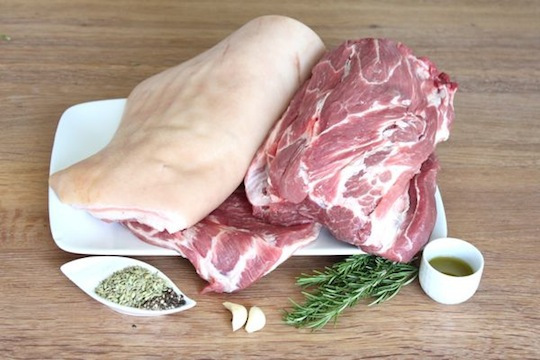
1 4 to 5 pound piece of fresh, skin-on pork belly (1.8 to 2.3 kg)
5 to 6 pounds pork shoulder, butter-flied to an even thickness of 1-inch (ask your butcher to butterfly it for you) (2.3 to 2.7 kg)
2 tablespoons fennel seeds (30 ml)
1 tablespoon black peppercorns (15 ml)
1 tablespoon chopped rosemary (15 ml)
1 tablespoon plus 2 teaspoons kosher salt (25 ml)
3 garlic cloves, minced
3 tablespoons olive oil (45 ml)
Instructions:
Toast the fennel seeds and peppercorns in a dry skillet over medium heat for 1 to 2 minutes until fragrant. Let cool then pulse a few times in a coffee grinder with the rosemary until the texture is finely ground but not powdery.
In a small bowl, use a fork to mash the spice mixture with the salt, garlic and olive oil to form a paste. Other seasonings that can be added to this mixture are roughly 1/2 cup (120 ml) or more of finely chopped fresh herbs, a teaspoon (5 ml) of red pepper flakes and a tablespoon (15 ml) of orange or lemon zest.
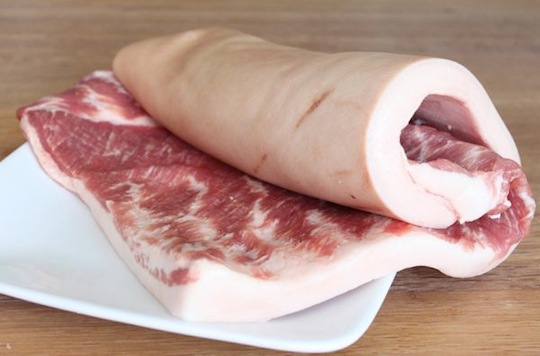
Lay the pork belly skin side up. Using a sharp knife (or utility knife) carefully score the skin in a tight crosshatch diamond pattern, cutting down to the fat but not through it (about 1/4 inch/6 mm deep). The skin can be a little hard to cut through, but scoring it is essential if you want the skin to become as crispy as possible.
Flip the belly over, skin side down, and score the meat side in the same crosshatch diamond pattern. Rub a little bit of the spice and garlic paste all over the pork belly.
With the pork belly lying skin-side down, lay the butter-filed pork shoulder on top of it. Spread the remaining spice mixture on the side of the pork shoulder that’s facing up.
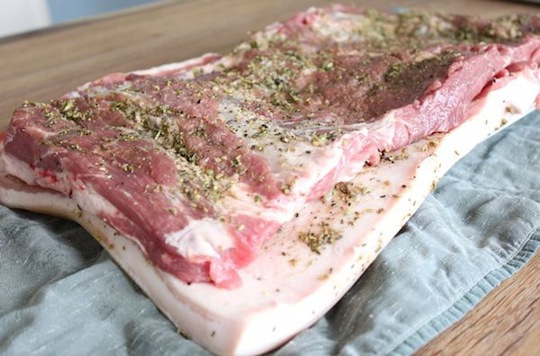
Leaving the pork belly alone for now, just roll the shoulder up as tightly as possible so it looks like a long, fat pork loin. Put the rolled pork shoulder near the middle of the pork belly and fold the belly all the way over the shoulder.
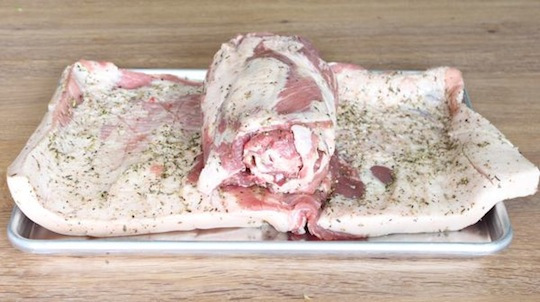
Roll it once so the two ends of the belly overlap just slightly and the shoulder is completely covered in a draping of belly fat.
**If there’s a gap on the underside because the pork belly doesn’t reach all the way around, that’s fine. Or, if you just have a small piece of pork belly, simply drape the belly over the top of the shoulder.
Once the pork belly is snugly around the shoulder, use cooking twine/string to tie the belly to the shoulder in 2-inch/5 cm intervals as tightly as possible. This is easiest with two people; one person holds the porchetta together and one ties the strings.
If the ends of the rolled pork are uneven and pork belly or pork shoulder is hanging out, use a kitchen shears to trim the ends of the belly or shoulder so they are even.
Transfer the porchetta to a wire rack set in a rimmed baking sheet or roasting pan. Sprinkle a light layer of salt on top. Refrigerate the pork uncovered overnight.
The next day, bring the roast to room temperature for 1 hour.
Preheat the oven to 450 ºF (232 ºC)
Put the porchetta in the oven and roast for 45 minutes.
Turn the heat down to 325 ºF (163 ºC) and continue to roast the porchetta until a thermometer stuck into the middle of the roast registers between 150 ºF (66 ºC) and 160 ºF (71 ºC). This will take around 2 to 2 1/2 hours more.
Let the porchetta rest for 30 minutes before slicing thinly.
To reheat porchetta leftovers the next day, heat up slices under the broiler until the fatty layers are soft and supple again.
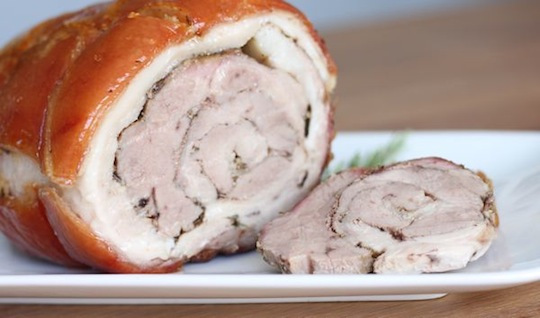
Not Sure What to Eat? Get the Primal Blueprint Meal Plan for Shopping Lists and Recipes Delivered Directly to Your Inbox Each Week

June 7, 2013
Grok the High Schooler
It’s Friday, everyone! And that means another Primal Blueprint Real Life Story from a Mark’s Daily Apple reader. If you have your own success story and would like to share it with me and the Mark’s Daily Apple community please contact me here. I’ll continue to publish these each Friday as long as they keep coming in. Thank you for reading!
 My name is Christy and I’m an 18 year old high school student. I’m an athlete, primal fitness enthusiast and have been paleo for over a year now. I’m pretty much your standard high school Grok. I do my best to sleep when the sun goes down and move slowly many times throughout the day. It can be hard when you go to school, work, play sports…but I love everything about the paleo life. I enjoy long walks in my Vibrams and have been known to eat chicken and sweet potatoes multiple times a day…
My name is Christy and I’m an 18 year old high school student. I’m an athlete, primal fitness enthusiast and have been paleo for over a year now. I’m pretty much your standard high school Grok. I do my best to sleep when the sun goes down and move slowly many times throughout the day. It can be hard when you go to school, work, play sports…but I love everything about the paleo life. I enjoy long walks in my Vibrams and have been known to eat chicken and sweet potatoes multiple times a day…
I’ve always loved the outdoors. My earliest memories consist of afternoons in the park and endless trips to the zoo; you could find me swinging in the trees and splashing in the mud while the other kids clung to the jungle gym. My parents never complained…
Once I hit middle school I began to notice my weight. Keep in mind I always loved food and lots of it; I could proudly put down a rack of ribs or an entire order of P.F. Chang’s fried rice. I hit 125 lbs at 5’2”, not obese by any means but a bit pudgy for my taste. So I cut back on the rice, upped the chicken and veggies, and hit about 118 lbs feeling great and as though I had taken control of my body for the first time. This sparked my interest in nutrition and sent me into high school feeling great.
I went into my freshman year as a varsity tennis player and track runner. I began sprinting and power lifting, falling in love with cleans, squats, and bench presses and could easily crank out 10 pull-ups. I loved lifting, but I missed running as I was a pole vaulter, so I naturally began doing extra on the weekends causing me to burnout by the end of the season.

Track gave me a new passion for fitness and a desire to change my body, so I continued working out through the summer, slimming down to 108 lbs but losing a large amount of muscle. I was lethargic most of the day, running each morning and thinking about food constantly; I wasn’t following a certain diet but restricted my portions and ate foods like low fat cereal, turkey wraps, and chicken, veggies and rice for dinner. I stopped menstruating and became irritable. I stopped strength training because I lost all desire to lift. I stayed slim for the next two years, eating more and lifting again throughout the school year but I still obsessed over food and staying thin rather than my overall health.
So I tried out for the girls lacrosse team my junior year never having played, which gave me the motivation to eat more and focus on what I could do rather than what I weighed. I wanted to reach my maximum potential physically, so I trained twice a day, eating things like Greek yogurt, oats, chocolate milk and Gatorade. I turned myself into a decent player but would burn out easily as I ran mostly on sugar. It was frustrating for me because after all these years of dieting and working out I felt I should have been the fittest girl there was, so I continued to look for answers.
I saw “The Paleo Diet for Athletes” one day on Easter vacation, read it and felt an immediate light go off in my mind. Eating what our bodies were meant to eat, plenty of meat, fresh fruits and veggies (I’d always enjoyed carrots out of the bag), this diet couldn’t have been more perfect.
I ate high carb at first, not quite grasping the “fat is GOOD” concept. I fueled up with egg whites and spinach, fruit, carrots, Lara bars, nuts, DATES, and smoothies and was feeling good but was having some minor stomach pains due to excess fiber/sugar. I immediately had more energy and felt how efficiently my body was beginning to run. My year ended with a few too many hard workouts and carb cravings, so I reduced the cardio, took up sprint days, plyos, hiking and rock climbing and had the best summer of my life. I ditched processed foods and cooked more, bought Vibrams, went out with friends and enjoyed life. I was feeling great and headed into my cardio-heavy tennis preseason eating eggs, grass fed butter, sweet potatoes, and plenty of meat and veggies. I felt like a machine: no longer taking medication, sleeping soundly, working two jobs, and always having energy at the end of the night.

The success of that summer sent me into my senior year feeling better then ever. However being 18 provided many distractions and I derailed more than a few times. I ate ice cream, had cravings, binged, I got off track and back on, then got off again, but I never forgot how I felt that summer. Food had taken a grip on my mentality but I knew what a healthy body felt like. I wanted that body back so I kept fighting and eventually got back to the primal way. I know what my body likes and what it doesn’t, and while I still have days where I have a bit too much almond butter-dates-dark chocolate I always know I can come back to the foods I love and the training style that treats me right. I currently sit at a comfortable 120-123 lbs, can pump out 100 push-ups or an easy 4 mile run, and eat to fuel my performance, life and happiness.

By far the most rewarding part of this journey has been my friends asking why I do this “paleo thing” and if I recommend they try it. I give them your website, suggest what to eat, and answer any questions they have along the way. I’ve helped a best friend lose weight and change her life, given your website to complete strangers, and constantly use social media to expose the paleo life and express how passionate I am about it.
I’m heading to Penn State University to study Agricultural Sciences (where food comes from) and Dietetics and Nutrition (how to get the good stuff into people). I’m so excited and ready to help people beyond my close circle of supporters. I know I’m young and have a lifetime of information to learn, but I can’t wait to learn it and love having the energy to do so. Thanks, Mark, for inspiring me to inspire others everyday, for keeping me above the influence, and for making me the happiest, healthiest version of myself. I look forward to exploring campus next year and maintaining my diet throughout the year. Grok on!

Get the 7-Day Course on the Primal Blueprint Fundamentals for Lifelong Health Delivered to Your Inbox for FREE

Mark Sisson's Blog
- Mark Sisson's profile
- 199 followers



